Attainment Scotland Fund Evaluation: Reporting on Wider Evidence Sources, 2024
This report complements the NIF Measures Report by bringing together analysis of a wider set of national surveys and data, which offer further insights into the nature of the poverty-related attainment gap and the experiences of affected children and young people, and their families
Executive Summary
1. This report is part of the Attainment Scotland Fund (ASF) Evaluation, which assesses progress towards closing the poverty-related attainment and health and wellbeing gap, and the contribution of the Fund in achieving this. The main reporting on progress is undertaken through monitoring of the National Improvement Framework (NIF) measures of the attainment gap. This report complements the NIF measures report by bringing together analysis of a wider set of national surveys and data, which offer further insights into the nature of the poverty-related attainment gap and the experiences of children and young people, and their families, who are most affected by it.
2. The report focuses on evidence in relation to three of the Evaluation Questions which underpin the ASF Evaluation. This evidence is summarised under each Evaluation Question below:
To what extent did the fund contribute to a closing of the attainment gap between the most and least socio-economically disadvantaged children and young people, in line with the refreshed Scottish Attainment Challenge Mission?
3. The evidence utilised in this report indicates progress in closing the poverty-related attainment gap. This includes a narrowing of the gap in the wider qualifications measure (All SCQF); improved outcomes for Care Experienced Children and Young People; and, a record number of entrants to higher education from the most deprived SIMD areas.
4. The All SCQF Measure, which is a wider measure of attainment and achievement than the National Qualifications measure, shows that the attainment gap between pupils from the most and least deprived areas has narrowed considerably in the last 15 years. At one or more awards at SCQF Level 5, the gap reduced from 32.1 percentage points in 2009/10 to 16.6 percentage points in 2022/23.
5. The Widening Access to Higher Education figures show significant progress. In 2022/23, a record number of young people from both the most deprived SIMD areas and from Care Experienced backgrounds gained places in Higher Education.
6. The Care Experienced Children and Young People Fund, part of the ASF, is aimed at improving educational outcomes for this group. This is mainly measured by data on Looked After Children, which showed that more Looked After Children are staying in school for longer, and achieving higher qualifications than previously. However, there are still large gaps compared with all pupils.
To what extent did the fund contribute to an education system which encourages, reflects and values the breadth of achievements that contribute to improved outcomes for children and young people?
7. The Scottish Attainment Challenge Refresh in April 2022 included a broader recognition of children and young people's achievements and attainment through the policy's mission to use education to improve outcomes for children and young people impacted by poverty.
8. The All SCQF Measure of attainment, which includes all awards including those outside of SQA qualifications, shows that the number of award providers, types of awards, and young people achieving these awards, has increased significantly in the last 15 years. This measure shows a consistent narrowing of the poverty-related attainment gap, with the gap being narrower than for the National Qualifications measure (SQA only qualifications).
9. Various datasets, such as the Health and Wellbeing Survey and the Growing up in Scotland longitudinal study, show that young people in the most deprived areas in secondary schools were more likely than those in the least deprived areas to attend youth clubs and to have taken part in buddying or mentoring programmes. However, they were less likely to be working towards a Youth Award, or to participate in voluntary work or take part in sports clubs.
To what extent was there improvement in children and young people's readiness to learn through focusing on engagement, attendance, confidence and wellbeing?
10. COVID-19 had a clear impact on education, disproportionately on those from more deprived areas. Evidence shows that parents from the most deprived areas were more concerned about the impact of remote learning on their child's learning and wellbeing than parents in the least deprived areas, while results from PISA showed that 15 year olds in Scotland were more likely to agree that they had fallen behind on school work than their international peers.
11. Data on health and wellbeing provide important insights into the experiences of children and young people, and their families, on a range of measures. Data from the Growing up in Scotland survey show that the poverty-related gap in wellbeing starts before school, with data from the Health and Wellbeing survey showing how experiences of health and wellbeing differ by age and stage. The data show that the health and wellbeing gap is relatively narrow at P5, but widens between S1 and S3. However, further data is required to confirm this trend.
Characteristics of pupils living in relative deprivation
154,305 Number of school pupils living in the 20% most deprived areas in Scotland in 2022/23 – 22.1 per cent of all pupils
Proportion of pupils living in the 20% most deprived areas 46.3% in Scotland with an identified Additional Support Need
The impact of COVID-19 and school building closures
OECD’s PISA study reported that 56% of Scottish 15 years olds felt that they had fallen behind on school work during home learning.
A range of international and national data and research have indicated that school building closures during the pandemic impacted on education, and that those from relatively deprived socioeconomic backgrounds experienced a disproportionate impact.
Early Years and Primary School
The Growing up in Scotland longitudinal study has shown that, at age 5, compared with children in the lowest income quintile, those with the highest income quintile were around 13 months ahead in their knowledge of vocabulary and 10 months ahead in their problemsolving ability.
Primary-Secondary Transitions
Analysis of Growing up in Scotland data has shown that there was a 19 percentage point difference in positive transitions between the top and bottom income quintiles in the study.
Educational Outcomes for Care Experienced Children and Young People
More Looked After children are staying in school for longer, and achieving higher qualifications. However, there are still large gaps compared with all pupils.
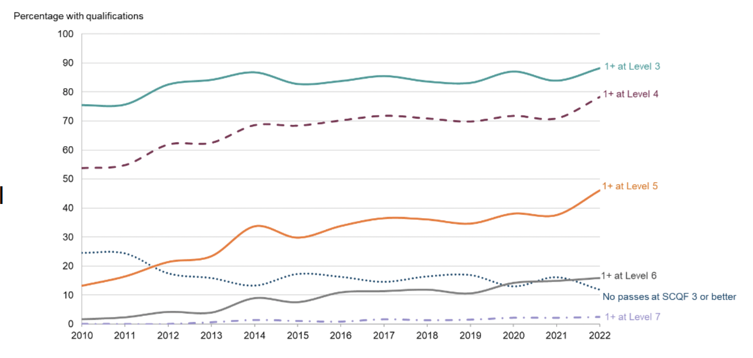
Attainment – All SCQF measure
The All SCQF Measure describes attainment in any qualification or learning programme on the Scottish Credit and Qualifications Framework (SCQF).
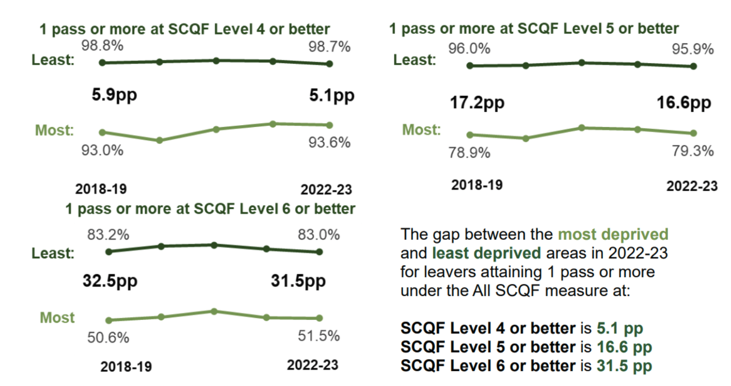
The All SCQF Measure shows that there has been a long-term increase in the proportion of pupils, particularly those in more deprived areas, attaining at SCQF levels 4-6. At levels SCQF 4 and 6, the attainment gap in 2022/23 was at its narrowest since 2009/10, while at SCQF Level 5, it was narrower than at any point other than 2020/21 and 2021/22.
Attainment – PISA
PISA measures the strength of the relationship between social background and performance by the share of variation in scores explained by the index of Economic, Social and Cultural Status (ESCS).
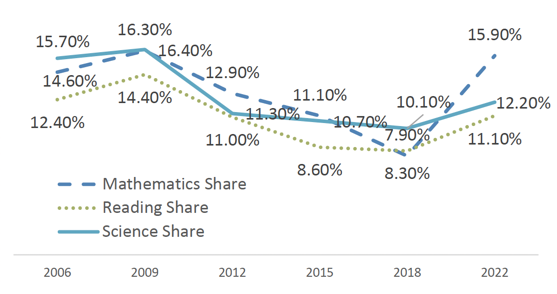
Between 2009 and 2018 there was a steady reduction in the strength of the relationship between students’ socio-economic background and scores in PISA. However, following the COVID-19 pandemic, there was an increase in the strength of the relationship in Maths in PISA 2022.
Positive destinations – Widening Access to Higher Education
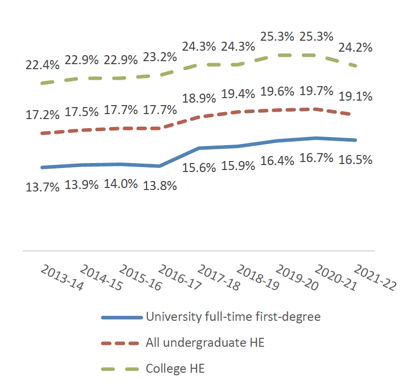
There has been substantial progress in widening access to higher education, with a record number of entrants from the most deprived areas, as well as Care Experienced Children and Young People, entering a degree course in 2021/22.
Much of the progress in increasing the number of SIMD 1 entrants is due to an increase in participation among female students.
Attitudes to school
The Health and Wellbeing Census1, undertaken in schools for first time in 2021/22, explored the attitudes and experiences of school across P5 to S6. The results showed that those living in areas of high deprivation were less likely to have a positive view and experience of education on some measures, particularly in secondary school.
The largest gap between pupils from SIMD 1 and SIMD 5 is for those agreeing that ‘most of the time I am happy at school’. There was a 10 percentage point gap between SIMD 1 and SIMD 5 pupils between S1 and S3 and at S6 on this statement.
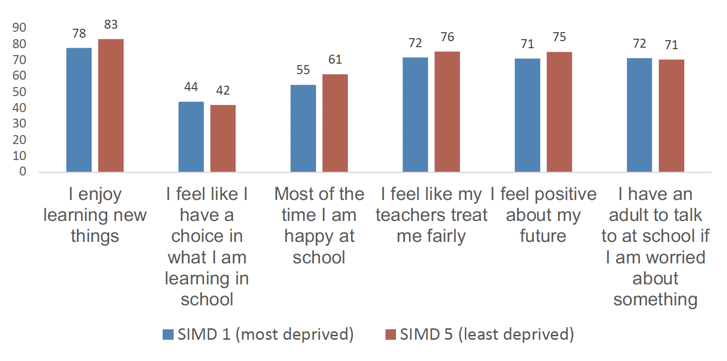
Contact
Email: socialresearch@gov.scot
There is a problem
Thanks for your feedback